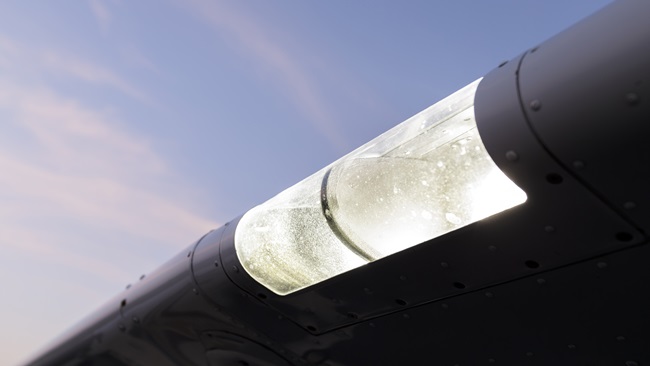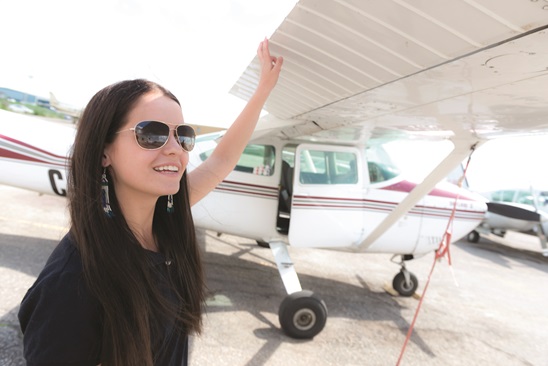A bush airplane that pampers you with luxury and cruises at 175 knots
Typically, if someone is described as two-faced, it's a derogatory remark. In the case of an airplane, though, it can be a huge compliment. Such is the case with Cessna's new T206 Turbo Stationair. By the time the throttle reached the firewall on the first takeoff, I knew this was not going to be like the last few turbocharged singles I had flown. Even the most hardened bush pilot would be impressed with the luxurious new T206's performance. Likewise, the typical pilot looking for an airborne family hauler would be foolish to turn his back to this airplane.
Let's cut right to the numbers. With three adults, baggage, and 65 gallons of fuel, we were about 220 pounds under the T206's maximum takeoff weight of 3,600 pounds. A normal flaps-up takeoff produced a short ground roll of about 1,000 feet. We began a spirited climb of 1,500 feet per minute at the airplane's 90-knot best-rate-of-climb airspeed. Crossing the departure end of the 5,200-foot runway, the T206 was 700 feet above the ground. Rates of climb like this are typically seen only in high-powered twins. Likewise, the 34 gallons per hour that the turbocharged Lycoming consumes on takeoff would be more typical of a twin. But what do you expect from a go-anywhere family hauler?
Ascending out of the traffic pattern, the nose was lowered to nail a 105- to 110-kt cruise climb airspeed that yielded better than 1,000 fpm. Thanks to turbocharging (and the built-in oxygen system) we continued to race upward, passing 10,000 feet eight minutes after takeoff and 15,000 feet only 13 minutes after takeoff. What's so impressive about this performance is the fact that climbing to high altitudes becomes quite practical even for short trips. Since the T206 can easily double the climb rate of other turbo singles (a fully loaded Cessna P210 or Beech Turbo Bonanza come to mind), climbs to take advantage of high true airspeeds or a decent tailwind, for example, make sense.
We continued up to 17,500 feet at 1,000 fpm and leveled off to take some numbers. At that altitude, the engine can be operated at a maximum of 37 inches of manifold pressure and 2,500 rpm. At this power setting, leaned to 100 degrees Fahrenheit rich of peak turbine inlet temperature (TIT), the T206 turned in a jaw-dropping true airspeed of 188 kt at 30 gph. That's a full 10 kt better than the published maximum speed and not far off from the Beech Baron that I regularly fly. Not bad for a fixed-gear bug smacker.
Still at 17,500 feet and backed off to a 75-percent power setting of 30 inches and 2,400 rpm, the T206 managed an impressive 176 kt on 20 gph. Leaned to peak TIT, the speed dropped to 172 kt on 16.5 gph. Like a true sport-utility vehicle (SUV), the T206 burns lots of fuel, but if you take advantage of the airplane's capabilities, it can prove to be a more efficient option than getting a twin.
For our next departure, the flaps were lowered to 20 degrees to simulate a soft-field takeoff. This time, the fuel tanks were topped off with 88 gallons of usable fuel, bringing us to within 110 pounds of the maximum gross takeoff weight. Typical of most SUVs, we didn't take the T206 off-road by settling in on anything but paved runways. (A soaking rain the day prior to our flight caused concern about getting the new Stationair stuck in the muck. Had our demonstrator been equipped with the oversized wheels and tires, a $2,600 option, we wouldn't have had second thoughts about trying them out.) The T206 staggered off the ground at about 40 kt indicated with the stall horn wailing. Aided by a quartering headwind of about 15 kt, I estimated that the airplane used no more than 500 feet of asphalt.
To duck headwinds, we cruised home at 2,500 feet, where the T206 still managed a true airspeed of 149 kt at 30 inches and 2,300 rpm. At that power setting, the noise in the cabin was measured as 91 dBA in the front and 90 dBA in the rear - fairly typical readings for a high-powered single.
Overall, the handling of the 206 is not going to be mistaken for that of a sport airplane. It is fairly truck-like and has ponderous yaw stability at low airspeeds. A yaw damper would be a nice option in this airplane. Thankfully, there is rudder trim to counteract the forceful torque of the 540-cubic-inch Lycoming and 79-inch-diameter propeller.
Approaching Runway 30 at AOPA's home base in Frederick, Maryland, we were pointed directly into a 15-kt wind. Even though it seemed we were impossibly high on final, dropping the T206's big flaps to 40 degrees required a healthy addition of power just to make it to the end of the runway. With a little practice, you can make very steep - yet stabilized - approaches to the tiniest of runways with the T206. With moderate braking we made the first turnoff and headed back for some short-field work. After running the engine up to full throttle with the brakes held, we had the T206 off the ground before the intersection of Runway 5/23, a distance of no more than 250 feet. This was getting to be fun.
In all, the turbo system adds about 75 to 80 pounds to the airframe, including the 78-cubic-foot oxygen system and larger oil cooler. Overall, the new-to-the-206 Lycoming TIO-540 engine was very smooth, like the Continental TSIO-520 engine that powered the 206 through the end of production in 1986. Although it would appear that the ominous cowling enclosing the new engine would impede forward visibility, I failed to notice any significant difference between it and the Continental-powered Aero SUV Sweepstakes 206 that AOPA recently awarded.
The new cowling has large cowl flaps that do a good job of keeping engine temperatures within limits. Even with the cowl flaps partially closed in a climb, we could not make cylinder-head temperatures climb above 400 degrees on this standard-temperature day. Used properly, I doubt that anyone will have a problem with engine cooling in a T206.
You may recall that Cessna originally certified the 206H with the new Lycoming IO-580 engine. Those plans were scrapped when the engine failed to meet the requirements of a 500-hour endurance test. Cessna officials say there are no current plans to incorporate the IO-580, which is still under development at Lycoming. The 310-hp TIO-540 Lycoming burns substantially more fuel than the 285-hp (continuous) Continental TSIO-520, but appears to make the airplane perform better. Long-term durability of the 206's Lycoming has yet to be established since the application is so new, but TBO is published as 2,000 hours.
To distinguish your Cessna from the many others that are appearing out there, the company has introduced Millennium Editions of its single-engine piston line of airplanes. Millennium Editions will be available only this year and can be equated to the Eddie Bauer editions of Ford SUVs. On the exterior, Millennium Cessnas can be spotted by a new graphics treatment, a polished spinner, Goodyear Flight Custom II tires, and stainless steel cowl fasteners. Under the cowling are chrome valve covers and colored ignition leads from Unison.
Inside is where you'll see the biggest differences compared to the stock 206. Millennium Editions (available for the 172SP, Skylane, and Stationair) are all outfitted in leather with the logo embossed into the seat backs, yokes, and floor mats. Rosen tinted sun visors reside at the top of the windshield, rather than the opaque gray plastic panels used in standard Cessnas. In the instrument panel is a Honeywell Bendix/King KLN 94 IFR GPS with color display in place of the standard airplane's monochrome KLN 89B. Finally, there is a handy removable chart and cup holder to increase storage capacity, a nice thing to have in Cessnas, which are typically skimpy on chart storage. For the 206, the Millennium Edition will add $6,300 to the price tag. Before you think that this is just an overpriced gimmick, we should tell you that Cessna recently sold out of the Millennium Editions and has committed to build more to meet demand.
Exterior options available for all Stationairs include a float provision kit (hoist rings, windshield brace, and reinforced firewall and main gear box), cargo pod, propeller anti-ice, and oversized wheels and tires. Floats are available via STC from Wipaire. On the interior, leather seats or a utility vinyl interior can be had. For the panel, an HSI, ADF, IFR GPS, and two-axis autopilot with electric trim can be installed. In addition to options available from the factory, the availability of several aftermarket STCs is an attractive advantage of buying a Cessna.
One STC likely to be popular is the installation of auxiliary fuel tanks to supply that thirsty Lycoming and raise the airplane's useful load. Range and endurance are about the only shortcomings of the new T206. With 88 gallons usable on board and an average fuel burn of 25 gallons for the first hour and 20 for each hour thereafter, you'll have dry tanks in a little more than four hours at 75-percent power. Flint Aero of El Cajon, California, has applied for an STC that will add 30 gallons of fuel to the H model Stationairs as well as add 200 pounds to the maximum takeoff weight. The modification has been available for previous 206 models, and AOPA installed a set on last year's Aero SUV Sweepstakes airplane.
Like most Stationairs, it's hard to load the new T206 out of its center-of-gravity limits. A good rule of thumb is that if after loading you notice that the nosewheel is off the ground, you'd better go check the numbers. The rear bench seat is easily removed by yanking eight pins and hoisting it out the giant utility doors. Once removed, there's enough room for all sorts of ungainly cargo.
Cessna has solved a safety issue that has concerned 206s for years. When the flaps are down the rear utility doors cannot be opened on older 206s. This can be a serious safety hazard following a forced landing or ditching, since passengers can't exit out of that side. Cessna has incorporated a small gap at the wing root that allows the forward door to be opened far enough that the rear door can be fully opened, allowing emergency egress. There is also a clever mechanism that allows the rear doors to be locked without a key and without having to lock it from inside through the pilot's door. This feature results in less hassle and better security.
Base price for the T206 is $347,700. Loaded up with the more popular options such as an HSI, IFR GPS, two-axis autopilot, hot prop, and float kit, the T206 can top out at $387,970. The 206 is nearly alone in the fixed-gear, turbocharged single arena. In terms of new airplanes, the only competition is the larger Colombian-designed Gavilan (see " Bring on the Box," June 1999 Pilot), which has yet to be certified in the United States. But with its performance and simplicity, the unlikely 206 gives the slicker turbocharged, retractable singles (and even some twins) a run for their money. Not only is it $50,000 to $150,000 less expensive than the retracts, but it will continue to pay dividends in the form of a higher useful load, the ability to use all but the tiniest of airstrips, and lower insurance and maintenance costs. Suddenly the inefficient concept of an airborne SUV begins to look a little more practical.
Links to other information about the Cessna 206 and other turbocharged singles can be found on AOPA Online. E-mail the author at [email protected].
| 2000 Cessna T206 Millennium Edition Base price: $347,700 Price as tested: $387,970 |
|
|---|---|
| Specifications | |
| Powerplant | Lycoming TIO-540-AJ1A, 310 hp @ 2,500 rpm |
| Recommended TBO | 2,000 hr |
| Propeller | McCauley 3-blade, constant-speed, 79-in dia |
| Length | 28 ft 3 in |
| Height | 9 ft 3 in |
| Wingspan | 36 ft |
| Wing area | 174 sq ft |
| Wing loading | 20.7 lb/sq ft |
| Power loading | 11.6 lb/hp |
| Seats | 6 |
| Cabin length | 12 ft 1 in |
| Cabin width | 3 ft 8 in |
| Cabin height | 4 ft 2 in |
| Empty weight | 2,274 lb |
| Empty weight, as tested | 2,355 lb |
| Maximum ramp weight | 3,617 lb |
| Maximum gross weight | 3,600 lb |
| Useful load | 1,343 lb |
| Useful load, as tested | 1,262 lb |
| Payload w/full fuel | 815 lb |
| Payload w/full fuel, as tested | 734 lb |
| Maximum takeoff weight | 3,600 lb |
| Maximum landing weight | 3,600 lb |
| Fuel capacity, std | 92 gal (88 gal usable) 552 lb (528 lb usable) |
| Oil capacity | 11 qt |
| Baggage capacity | 180 lb |
| Performance | |
| Takeoff distance, ground roll | 910 ft |
| Takeoff distance over 50-ft obstacle | 1,740 ft |
| Max demonstrated crosswind component | 20 kt |
| Rate of climb, sea level | 1,050 fpm |
| Maximum level speed, 17,000 ft | 178 kt |
| Cruise speed/endurance w/45-min rsv, std fuel (fuel consumption) | |
| @ 75% power, best economy 20,000 ft |
164 kt/3.5 hr (114 pph/19 gph) |
| @ 65% power, best economy 24,000 ft |
153 kt/4.1 hr (97 pph/16.2 gph) |
| @ 55% power, best economy 24,000 ft |
137 kt/4.9 hr (85 pph/14.1 gph) |
| Service ceiling | 27,000 ft |
| Landing distance over 50-ft obstacle | 1,395 ft |
| Landing distance, ground roll | 735 ft |
| Limiting and Recommended Airspeeds | |
| V X (best angle of climb) | 69 KIAS |
| V Y (best rate of climb) | 89 KIAS |
| V A (design maneuvering) | 125 KIAS |
| V FE (max flap extended) | 140 KIAS |
| V NO (max structural cruising) | 149 KIAS |
| V NE (never exceed) | 182 KIAS |
| V R (rotation) | 55 KIAS |
| V S1 (stall, clean) | 50 KIAS |
| V SO (stall, in landing configuration) | 39 KIAS |
|
For more information, contact Cessna Single Engine Piston Aircraft, One Cessna Boulevard, Independence, Kansas 67301; telephone 800/423-7762 or 316/517-6056; or visit the Web site. All specifications are based on manufacturer's calculations. All performance figures are based on standard day, standard atmosphere, sea level, gross weight conditions unless otherwise noted. |
|


